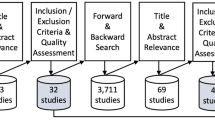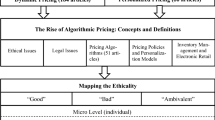Abstract
Formal merger analysis typically ignores the possibility that both prices and quality levels may be endogenous. This paper extends the traditional analysis of mergers to include both quality and price effects. Based on simulations, we find that mergers can either raise or lower the quality levels of the merging firms; non-merging firms always raise their quality levels. We find that while the standard upward pricing pressure index is a good predictor of the qualitative results of merger simulations, the equivalent index for quality performs poorly.
Similar content being viewed by others
Notes
The authors obtain sufficient conditions for price and quality levels of merging as well as non-merging firms to rise and fall. If these sufficient conditions do not hold, then the price and quality effects of a merger are ambiguous. A related paper by Tenn et al. (2010) examines the effects of mergers when firms compete in both prices and promotional activity, but their paper does not posit conditions under which mergers cause quality to rise or fall. Hereafter, we refer to Brekke et al. (2016) and Tenn et al. (2010) as BSS and TFT respectively. Qiu (2015) analyzes the price and quality effects of mergers in a logit model with three firms; but her results depend crucially on there being only three firms.
This question is not posed in BSS. In addition, the simulations that we report here concern changes in parameters that are not covered by the BSS sufficient conditions. The BSS conditions concern what they call the “degree of price competition” and the “degree of quality competition,” which involve cross-price and cross-quality effects on demands, as well as other terms. See BSS Propositions 4, 5, and 6 for sets of conditions under which the prices and quality levels of merging and non-merging firms rise and fall.
Cheung (2012) examines whether the usual upward pricing pressure index correctly predicts the signs of merger effects in a simulation model with the use of airline data.
Willig (2011) analyzes merger effects on hedonic prices and treats the value of the improvement in product quality as exogenous.
For convenience, we write that firm i sells product i prior to the merger. In the following subsection that describes firms’ decisions post merger, we let firms 1 and 2 merge, so that the merged entity sells products 1 and 2, and each firm \(i\notin \{1, 2\}\) sells product i as it did earlier.
The elasticities in the table are hypothetical. However, the own-price elasticity of \(-2.5\) is implied by a gross margin of 40 %, which is approximately correct for the wireless telephone industry.
See “AT&T Earnings Preview: Postpaid Subscriber Adds, Margin in Focus.” 7/22/2014. http://www.forbes.com/sites/greatspeculations/2014/07/22/att.
This particular value for \(\epsilon _{ii}\) was assumed in the parties’ analysis of the proposed merger between AT&T and T-Mobile.
TFT find that their simulated mergers cause prices to rise and promotional spending to fall. Because promotional spending in the TFT model plays the same role as quality in this one, their result is comparable to this base case result.
BSS also have this result.
When we vary the own-quality elasticity, given the base levels of \(q_i\) and \(s_i\), we are varying the own-quality coefficient in the demand function, \(\lambda _{ii}.\)
Of course, the diversion ratios that are used in the UPPI\(_{H_1}\) come from the true demand curves. Cheung (2012) points out that unilateral effects analysis often calculates diversion ratios from market shares. She finds that unilateral effects that are based on this procedure do a poor job of predicting the outcomes of merger simulations when the underlying demand curves are not logit.
We are indebted to the referees for pointing this out.
References
Brekke, K. R., Siciliani, L., & Straume O. R. (2016). Horizontal mergers and product quality. Unpublished manuscript.
Cheung, P. Y. L. (2012). Essays in Industrial Organization. Ph. D. thesis, University of Minnesota.
Dorfman, R., & Steiner, P. O. (1954). Optimal advertising and optimal quality. The American Economic Review, 44(5), 826–836.
Mathiesen, L., Nilsen, Ø. A., & Sørgard, L. (2012). A note on upward pricing pressure: The possibility of false positives. Journal of Competition Law and Economics, 8(4), 881–887.
Qiu, Z. (2015). Merger analysis with endogenous prices and product qualities.
Tenn, S., Froeb, L., & Tschantz, S. (2010). Mergers when firms compete by choosing both price and promotion. International Journal of Industrial Organization, 28(6), 695–707.
Willig, R. (2011). Unilateral competitive effects of mergers: Upward pricing pressure, product quality, and other extensions. Review of Industrial Organization, 39(1–2), 19–38.
Acknowledgments
We would like to acknowledge helpful comments from Gregory Werden, Luke Froeb, Steve Tschantz, Michael Doane, Michael Williams, and Manuel Castro. In particular, we are grateful to Jonathan Lhost for providing independent checks of our calculations and to Grace K. Lee for research assistance.
Author information
Authors and Affiliations
Corresponding author
Rights and permissions
About this article
Cite this article
Pinto, B.P., Sibley, D.S. Unilateral Effects with Endogenous Quality. Rev Ind Organ 49, 449–464 (2016). https://doi.org/10.1007/s11151-016-9504-5
Published:
Issue Date:
DOI: https://doi.org/10.1007/s11151-016-9504-5




